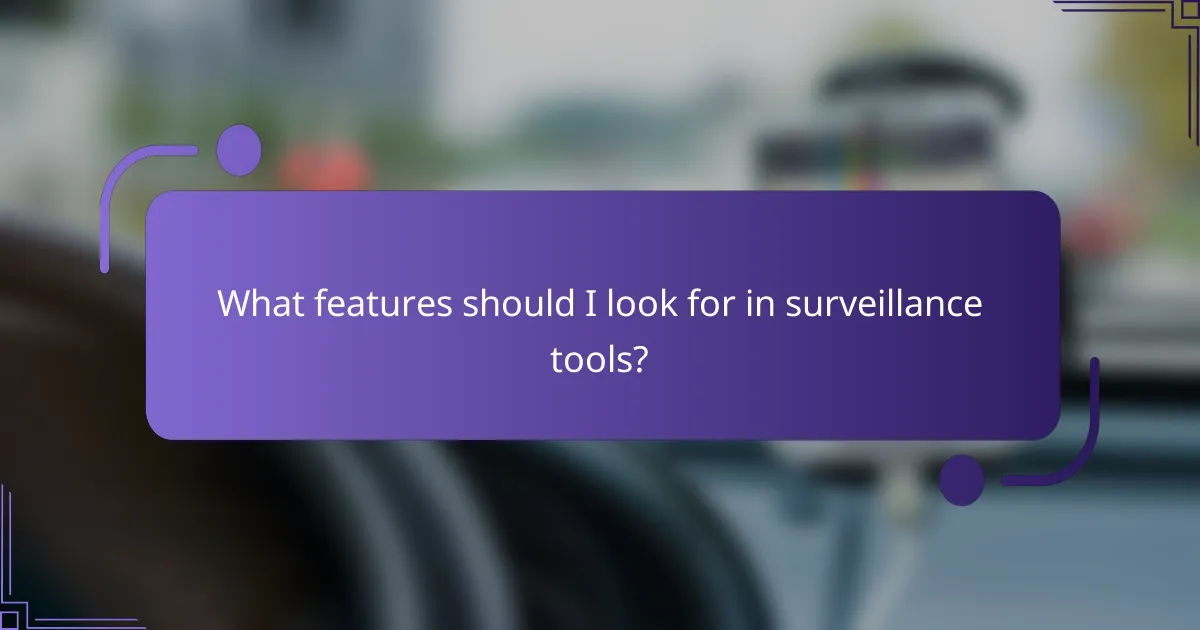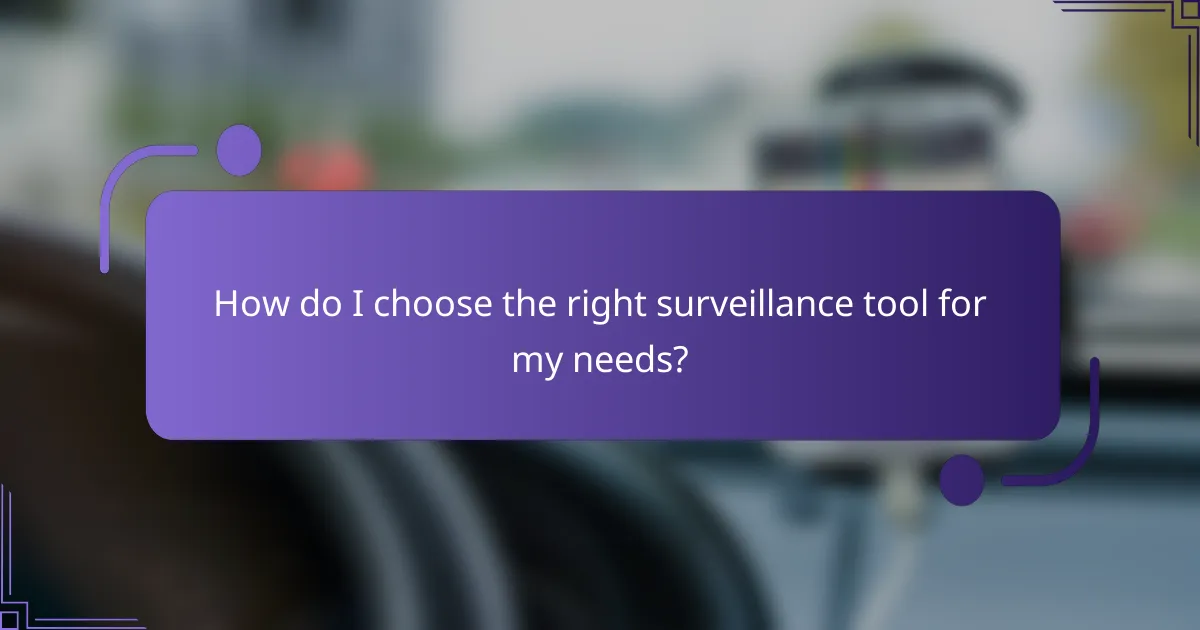Surveillance tools play a crucial role in enhancing security and monitoring across various environments. They encompass a range of systems, including video surveillance, access control, and GPS tracking, each designed to address specific security needs. By focusing on key features such as video quality and remote access, these tools provide significant benefits, including crime deterrence and valuable evidence collection, making them indispensable for both homes and businesses.

What are the types of surveillance tools available?
Surveillance tools can be categorized into several types, each serving distinct purposes in monitoring and security. These tools include video surveillance systems, access control systems, intrusion detection systems, GPS tracking devices, and network surveillance software.
Video surveillance systems
Video surveillance systems utilize cameras to monitor and record activities in specific areas. They can be analog or digital, with digital systems offering higher resolution and remote access capabilities.
When selecting a video surveillance system, consider factors such as camera resolution, storage capacity, and whether you need features like night vision or motion detection. For example, a system with 1080p resolution is typically sufficient for most residential and small business needs.
Access control systems
Access control systems manage who can enter specific areas by using credentials like key cards, biometric scans, or PIN codes. These systems help enhance security by restricting access to authorized personnel only.
When implementing an access control system, evaluate the types of credentials that best suit your environment. For instance, biometric systems may offer higher security but can be more expensive than traditional key card systems.
Intrusion detection systems
Intrusion detection systems monitor for unauthorized entry into a property and can trigger alarms or notifications. They typically use sensors placed on doors, windows, and motion-sensitive areas.
Choosing an intrusion detection system involves assessing the layout of your property and determining the best sensor types. For example, a combination of motion detectors and door/window sensors can provide comprehensive coverage.
GPS tracking devices
GPS tracking devices are used to monitor the location of vehicles or assets in real-time. These devices can be particularly useful for fleet management or personal safety applications.
When selecting a GPS tracking device, consider battery life, accuracy, and whether you need real-time tracking or periodic updates. Devices that offer geofencing features can alert you when an asset moves outside a designated area.
Network surveillance software
Network surveillance software monitors network traffic and detects suspicious activities or breaches. This type of software is essential for protecting sensitive data and ensuring compliance with regulations.
When implementing network surveillance software, look for features like real-time alerts, reporting capabilities, and compatibility with existing systems. Regular updates and training for staff can help maximize the effectiveness of your network security measures.

What features should I look for in surveillance tools?
When selecting surveillance tools, focus on features that enhance security and usability. Key aspects include video quality, remote access, motion detection, data protection, and compatibility with smart home systems.
High-resolution video quality
High-resolution video quality is essential for clear image capture, allowing for better identification of individuals and events. Look for cameras that offer at least 1080p resolution, as this is generally sufficient for most surveillance needs.
Some advanced models provide 4K resolution, which can be beneficial in larger areas or for detailed monitoring. However, higher resolution may require more storage space and bandwidth, so consider your system’s capacity.
Remote access capabilities
Remote access capabilities enable you to view live feeds and recorded footage from anywhere using a smartphone or computer. This feature is crucial for monitoring your property while away, providing peace of mind.
Ensure the surveillance tool supports a user-friendly app or web interface. Look for options that allow for multiple user access and notifications for unusual activity to enhance security further.
Motion detection technology
Motion detection technology helps to identify movement within the camera’s field of view, triggering alerts or recording events. This feature is vital for reducing false alarms and conserving storage space by only capturing relevant footage.
Consider tools with adjustable sensitivity settings to minimize unnecessary alerts from pets or environmental changes. Some systems also offer advanced features like person detection, which can differentiate between people and objects.
Data encryption
Data encryption is crucial for protecting your surveillance footage from unauthorized access. Look for tools that offer end-to-end encryption, ensuring that data is secure both during transmission and storage.
Additionally, check if the surveillance system complies with local data protection regulations, such as GDPR in Europe, to safeguard personal information and maintain privacy standards.
Integration with smart home systems
Integration with smart home systems allows for seamless operation and enhanced functionality of your surveillance tools. This feature enables you to connect cameras with other devices like alarms, lights, and smart locks for a comprehensive security solution.
Choose surveillance tools that are compatible with popular smart home platforms, such as Google Home or Amazon Alexa. This compatibility can simplify control and automation, improving overall security management.

What are the benefits of using surveillance tools?
Surveillance tools offer various benefits, including improved security, crime deterrence, and valuable evidence collection. These advantages make them essential for both residential and commercial settings, enhancing overall safety and peace of mind.
Enhanced security and safety
Surveillance tools significantly enhance security by providing constant monitoring of premises. Cameras and alarm systems can deter unauthorized access and alert property owners to potential threats in real-time. This proactive approach helps ensure a safer environment for individuals and businesses alike.
Incorporating surveillance systems can also lead to a reduction in crime rates in the surrounding area. When potential criminals see visible security measures, they are less likely to target properties equipped with such tools.
Deterrence of criminal activity
The presence of surveillance cameras can effectively deter criminal activity. Studies show that properties with visible cameras experience lower rates of vandalism and theft. Criminals often avoid locations where they know they are being watched.
Additionally, signage indicating that an area is under surveillance can further discourage illegal behavior. This simple measure can enhance the perceived risk for would-be offenders, making them think twice before attempting a crime.
Evidence collection for investigations
Surveillance tools are invaluable for collecting evidence during investigations. Recorded footage can provide crucial information regarding incidents, helping law enforcement identify suspects and understand the sequence of events. This evidence can be vital in court proceedings.
Moreover, having clear video or photographic evidence can expedite investigations and lead to quicker resolutions. This can be particularly beneficial for businesses facing disputes or incidents on their premises.
Remote monitoring for peace of mind
Many modern surveillance systems offer remote monitoring capabilities, allowing users to keep an eye on their property from anywhere. This feature is especially useful for business owners and homeowners who travel frequently or spend time away from their properties.
With mobile apps and web interfaces, users can receive real-time alerts and view live feeds, ensuring they are always connected to their security systems. This level of accessibility enhances peace of mind, knowing that one can monitor their surroundings at any time.
Insurance benefits and discounts
Installing surveillance tools can lead to insurance benefits, including lower premiums. Many insurance companies offer discounts for properties equipped with security systems, as they reduce the risk of theft and damage.
Homeowners and business owners should check with their insurance providers to understand potential savings. Documenting the installation of surveillance tools can help in negotiating better rates and ensuring adequate coverage.

How do I choose the right surveillance tool for my needs?
To choose the right surveillance tool, assess your specific requirements, such as the environment, type of monitoring needed, and budget. Consider factors like ease of use, features, and compliance with local regulations to ensure the tool meets your needs effectively.
Types of surveillance tools
Surveillance tools can be categorized into several types, including video surveillance systems, access control systems, and alarm systems. Video surveillance systems often include CCTV cameras and digital video recorders, while access control systems manage entry through keycards or biometric scanners. Alarm systems typically involve motion detectors and alerts for unauthorized access.
Each type serves different purposes; for instance, video surveillance is ideal for monitoring large areas, whereas access control is essential for securing specific entry points. Understanding these distinctions helps in selecting the most suitable tool for your situation.
Features to consider
When evaluating surveillance tools, consider features such as image resolution, storage capacity, remote access, and integration capabilities. High-resolution cameras provide clearer images, while ample storage ensures you can retain footage for necessary periods. Remote access allows monitoring from anywhere, which is increasingly important for businesses and homeowners alike.
Integration with existing security systems can enhance functionality, allowing for a more cohesive security strategy. Look for tools that offer user-friendly interfaces and mobile app support for convenient management.
Benefits of using surveillance tools
Utilizing surveillance tools can significantly enhance security, deter criminal activity, and provide valuable evidence in case of incidents. They can also improve operational efficiency by monitoring employee productivity and ensuring compliance with safety regulations.
Moreover, modern surveillance systems often come with advanced analytics, enabling users to identify patterns and trends over time. This data can inform better decision-making and resource allocation, ultimately leading to improved safety and security outcomes.
